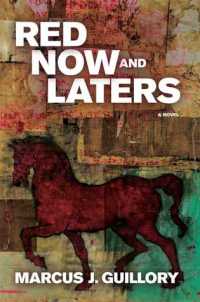Red Now and Laters by Marcus J. Guillory
 Monday, March 10, 2014 at 9:55AM
Monday, March 10, 2014 at 9:55AM 
Published by Atria Books on March 11, 2014
From the first sentence ("God's tears were brown."), the prose in Red Now and Laters screams for attention. Sometimes the screams hurt the reader's ears but it is always lively and much of it is innovative. The novel opens in 1977 as a flood in the Houston neighborhood of South Park forces John Boudreaux Jr. ("John Frenchy") to carry his son, Ti' John, to safety across the rising brown waters. "John Frenchy" is a star on the black rodeo circuit. His family is Creole and he is a transplant from Louisiana, as are many black families in South Park.
The story resumes three years later, when Ti' John is eight. The reader jumps into Ti' John's life again at various ages from 12 to 17 as he encounters random death, has difficulty and success in different schools, seeks acceptance on Ricky Street (home to kids with tough reputations), serves as an undistinguished altar boy, learns to fight, grasps as much as he can about the mysterious ways of girls, and comes to terms with his family. Ti' John is an imaginative child trying to understand the workings of the adult world. In many respects, he is a memorable character. Along the way Ti' John and other characters riff on topics of interest and amusement, including the relationship between gospel music and blues (both "testaments to the human spirit and personal realizations"), the relationship between luck and race, breasts, sex, hospital waiting rooms, and the difference between Cajun and Creole.
Interludes take place in Opelousas a generation earlier, where John Frenchy and his future wife Patrice are growing up. Eventually the story retreats to 1870 where Jules Saint-Pierre Sonnier (whose biological father was a Boudreaux) arrives in Louisiana from Haiti. Sonnier is a practitioner of voodoo and his story is freakish. Others in the Sonnier line (who generally share freakishness as a family trait) play roles in the story, sometimes after they have died. Footnotes scattered through the novel translate French phrases and enlighten the reader about (among other topics) Creole history and the rules of dice.
Issues of skin color form one of the novel's themes. Patrice wants to be lighter so she will be accepted by the lighter members of her extended family; Ti' John wants to be darker so he won't be beaten by the darker kids on Ricky Street. The role of religion in the black community and of superstition in the Creole community is another theme, as is the relationship between religion and superstition. To an extent, this is a "black man coming of age in a white society" story, a theme that has been done many times, but the novel makes a strong point about the difficulty (but not necessarily impossibility) of escaping what seems to be a preprogrammed life, and does so in an original way. The novel's moral is: whether or not fate exists, whether or not we can escape our fate, "we continue into the unknown with delusions of certainty as a safety blanket and we hope the next day will be kinder than the last."
There is a supernatural element to the story, both in the healing powers that John Frenchy and Ti' John display and in the occasional appearances of a dead Sonnier in their lives. Given the role that superstition has played in Creole culture, that aspect of the story is not out of place, but I can't say that it entirely worked for me. Ti' John's connection to the supernatural is underplayed for most of the novel, making it a bit jarring when it gains a more prominent role late in the story. I suspect that the witchcraft is intended as a metaphor but this might have been a better novel without it.
While Marcus Guillory's writing is strong, occasional passages try too hard to be startling and succeed only at being awkward. Sometimes the story seems a bit scattered but the story's energy and power overcome its structural problems. In the end, Red Now and Laters isn't a perfect novel, but it is well worth reading.
RECOMMENDED
Reader Comments